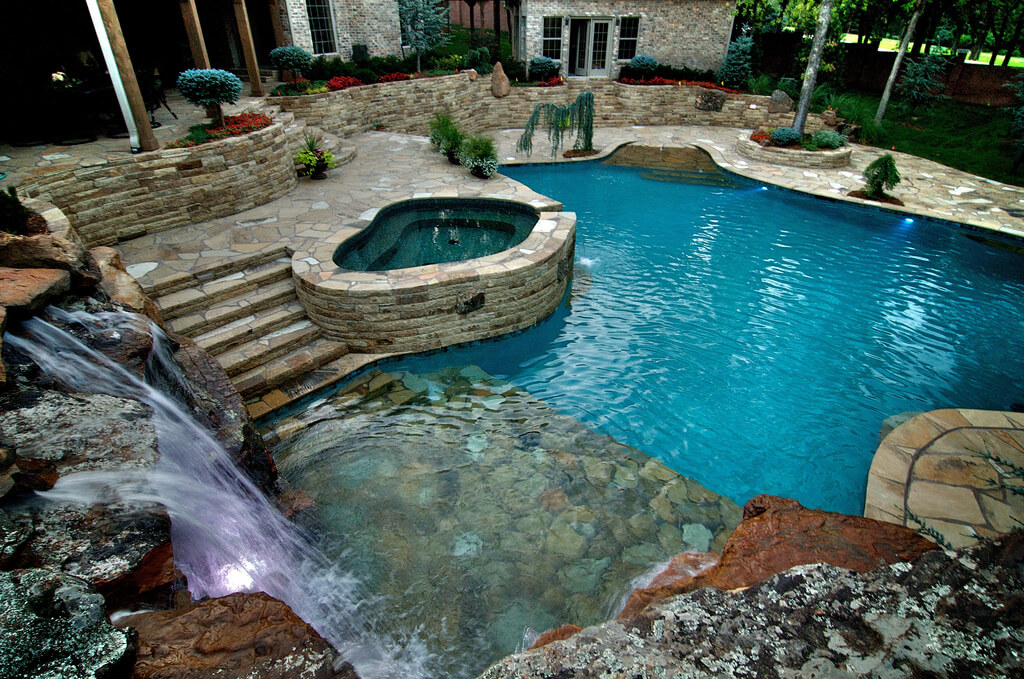
How To Choose What Is Right For You?
Many homeowners consider upgrading their homes by installing a hot tub or spa.
Both of these options are relaxing and pleasant and both will improve your life and will improve the overall value of your home. Your friends and family will be impressed and will want to come over and enjoy it with you; whether or not you invite them is up to you, of course.
If you’re thinking about purchasing and installing a hot tub or spa in your home, you may be unsure about which is better for you and your needs.
Many people don’t know the differences between hot tubs vs. spas, and that may be holding you back on moving forward with your plan. In this informative post, we’ll explain the similarities and differences, and we’ll help you decide between the two. Read on.
Hot Tubs Defined
You’ve probably spent time in a hot tub before and have enjoyed it; they are quite popular at homes, hotels, and resorts. A hot tub is a self-contained, standalone vessel that holds water that can be heated and it can function independently and separately from a pool. The plumbing and heating elements are part of it. Because of this, it can be enjoyed in one location and then it can be drained and relocated to a new location. If you move to a new home, you can bring your hot tub along with you.
Hot tubs offer a variety of seating options and, in most cases, quite a few jets for massage purposes. They can hold a warm temperature for a long period and are easy to care for and maintain.
Spas Defined
On the other hand, a spa is built into the ground, like an in-ground pool. In fact, a spa is often connected to an in-ground pool and users can jump or slide over a low wall or barrier to move back and forth from one to the other. Often, you’ll find spas in gyms and health clubs. They usually offer bench seating and jets that massage users’ bodies while immersed.
Spas are sometimes bigger than hot tubs and because of this, they may have a hard time staying warm. The surface area is large and heat loss can occur more easily than it does in a smaller hot tub. However, spas are great if you want to enjoy the water with a group of friends; there is plenty of room for everyone in larger spas.
Spas are far more luxurious and classy than hot tubs; many people decide to have a spa installed, instead of a hot tub, for this reason.
Spillover Spa
A spillover spa is a water feature that is attached to an inground pool like a regular spa, but instead of being wholly separate from the pool, the water from the spa “spills over” into the pool like a small waterfall. This is a relaxing addition to any pool; the sound of flowing water is quite relaxing and it’s pleasing from a visual standpoint, too.
How They Differ From One Another
You’ve probably spent time in both hot tubs and spas in your life, but as a user rather than an owner, you may not have noticed any difference. However, as you can see from the above definitions, they are actually quite different for owners.
Both spas and hot tubs are great additions to any home. However, most people find that they prefer one over the other. A hot tub is often smaller, warmer, and easier to maintain, but if you enjoy entertaining, you might opt for a larger, permanent, in-ground spa instead, so you can spend time in it with your friends, family, and other guests.
Pros
As you can see, there are benefits to both options. When trying to decide between hot tubs vs spas, it’s important to consider the positive aspects of both.
Spas
The primary benefit of spas is that they are attached to a swimming pool; users can enjoy both options one right after the other, and can move back and forth between them. You can enjoy the flow of water from the jets while sitting on a bench and socializing with others. They are permanent structures that are built into the ground and users can enjoy them for years to come. They are elegant and are often quite beautiful to view.
Hot Tubs
On the other hand, there are many benefits of hot tubs as well. Hot tubs may be smaller, but they are easy to maintain and care for, and they get warm faster and stay that way. Since hot tubs are self-contained, you can move them to a new location on your property or even to a new property altogether if you decide to move. Also, many hot tubs have more jets than spas, which can be lovely if you enjoy water massage.
Cons
There are also always some cons to consider in every decision as well. If you’re trying to choose between a hot tub or spa, check out these negative aspects of each as well.
Spas
Spas are permanent structures and this can be a negative aspect for some. They are installed where they will stay forever and they cannot be moved without great effort and a redesign. Although most spas will last many years, because of their permanent structure, they can sometimes be expensive to repair if repairs are needed.
Hot Tubs
Hot tubs are great for a lot of reasons. Because of their self-contained construction, they can be moved easily, but they also tend to become old and out-of-style more quickly. You’ll likely want to replace a hot tub a lot sooner than you’ll want to replace a spa.
Which One is Better?
When it comes to determining which one is better in the battle of hot tubs vs spas, it really comes down to your own personal desires and opinions. Plenty of people enjoy both of these options and both of them will give you the opportunity to relax and enjoy the benefits of hydrotherapy in your own backyard alone or with others. Which you choose depends on which you like better personally.
Hot Tubs vs Spas: Two Fantastic Options
When it comes to choosing between hot tubs vs spas, you can’t go wrong. Either way, you will have upgraded your backyard and you will have a wonderful and pleasant place to relax just outside your door. If you’re interested in learning more about one or both of these options from a professional installer, contact us today. We can’t wait to offer you a quote and to advise; we look forward to hearing from you and we are ready to answer any and all questions that you may have.

Bert Minor has been a part of the landscaping business for nearly twenty years and has gained an excellent reputation as an innovative and creative designer. In fact, several of his designs and projects have been featured in industry supplier magazines. An active and contributing member of the industry, Bert sat on various boards including the Ottawa Chapter of Landscape Ontario and the Landscape Ontario Provincial Construction Committee. Bert also contributed technical articles published in the Canadian National Landscape Association magazine. With a relentless pursuit of knowledge, Bert has attained several industry certificates in landscape design, landscape construction and with the PHTCC—Pool and Hot Tub Council Canada. Prior to joining the landscaping industry, Bert spent several years in management in the services sector primarily in a customer advocate role. His honesty and integrity and his ability to build and develop strong relationships with clients reflects that.
